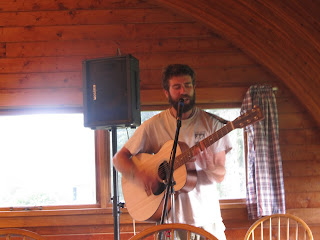To work with stone it will help to have a machine. We used the "Inland Swamp Top All-In-Wonder Lapidary Machine." It is a basic wet saw as would be used to cut tile but the top flips over and different attachments can be added for different purposes. From the middle ages up until the industrial revolution slabbing and polishing wheels were powered by water wheels in rivers. In Vermont, marble, slate, and granite are abundant and have been mined from the hills for hundreds of years. In fact, the first marble quarry in the United States was on Mount Aeolus overlooking East Dorset, Vt. Here is a description by Ronald Robinson of the marble quarries of Vermont in 1890:
"In the great pits, yawning wider and deeper every year, men and engines, in sunshine and in storm, delve all the seasons through. When the landscape is bright under the summer sun they may be seen, like ants toiling in their cells, hundreds of feet below the surface. Now and then an ant grows into a burly, grimy man, climbing the giddy stairs; or a small watercarrier, bearing, with careful steps, his heavy bucket to the thirsty workmen..."
The uses for polished stone are wide and varied. One could make soapstone chess pieces, obsidian arrow/spear/axe heads, obsidian scalpel edges such as the Incas used for surgery, inlays for belts/staffs/knife handles, mosaics, jewelry, paper weights, decorations, the list goes on. Today we just made some nice polished stones that can be altered further for various purposes. Here is how to do it.
After you select your stone, examine it to find what part of it you think will look best. You may want to check for cracks and faults as well to help determine which parts you would like to eliminate. The first step is to shape your stone using the diamond trim saw. Remove the top of the machine and set the blade in. Make sure to secure the arbor nut and note that like a table saw, it is tightened using a left hand thread. The trim saw will essentially achieve "slabbing" on a micro scale. Fill the water reservoir of the machine and connect the drain hose to a waste bucket. Set the drip valve to have 1 or 2 drops every second falling onto the blade. Turn the machine on, wet the stone, and slowly feed the stone into the blade. The blade should begin to cut through the stone and you should notice water and stone dust draining out the tube into the waste bucket. You can continue cutting through the stone at different angles until you achieve your desired slab trim. Depending on your stone, you may start to notice some nice colors and patterns in the interior of the stone. If the saw starts to struggle you may need to push less hard, turn the RPM's up or down, or apply more water to the stone and blade.




Next you will need to take off the top of the machine and remove the trim saw with an Allen key. Attach the edger/grinder/shaper tool. Use this tool to remove or add corners and further refine the shape of your stone. This tool uses the opposite side of the top facing up as a water reservoir and a guard.

Next remove the edger/grinder/shaper and attach the 6" "master lap" which is a white plastic disc. Set the lap horizontally and allow it to touch the plastic below it and then lift it up just a scoce and secure with the Allen key. This lap will give stability to your polishing laps. Begin with a 325 grit lap (coarse grain) and attach it to your master lap. Next setup your dop station. It is an electrical heating element that had a reservoir for wax and shlack. Melt some wax in the reservoir and heat your stone on the edge. Use a small dowel and dip it in the wax. Place the wax tip on a side of the stone that you are not going to polish and press the wax down with your fingers to secure the dowel to the stone. The dowel will be your handle to keep your hands safe while polishing. Hold the dowel, wet your stone and apply it to the spinning lap at different angles. Turn the stone around to grind away divots and other imperfections. Repeat this process using 600, 1200 and finally 14,000 grain lap. Note that the finer the grain the faster the RPM's should be. During the last lap which is the polishing phase, the stone should be dry. You will begin to see a nice sheen develop on the stone that can make it appear almost precious. If you want to polish the side that the dop is attached to, freeze the dop stone and wax and the wax should break off very easily. Apply the dop to the already polished side and finish the job. The result might just surprise you with its brilliance.
The dop station with wax and rocks heating

Dop applied to stone

Using the dop stick to polish a stone


Some finished stones shining with brilliance!










































